From small pieces of fabric craftswomen of different ages, places of residence and the degree of enthusiasm for needlework do amazing things. Patchwork, quilting, patchwork or patchwork mosaic - this is the name of the creative direction, which glorifies the connection of different pieces of fabric into a harmonious composition. It appeared a very long time ago. The patchwork has survived more than one wave of popularity, and today its demand is again at its peak.
What it is?
If you put shreds of fabric in a conceived order, like a mosaic, sew together and run on a typewriter, from dissimilar fragments you get a new product. It will be beautiful precisely due to various components, pleasant variegation and successful compositional solution.

It is impossible to say exactly where the patchwork came from. Mention of a combination of different fragments of tissue is in the sources of Ancient Egypt, China and Japan, India. So the progenitor of modern patchwork can be so ancient that it will be completely impossible to trace the entire history of the development of the direction.
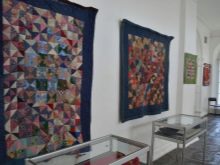


The assembly of a one-piece suit of shreds is more a part of the eastern tradition. And this was nothing more than a tribute to savings, constrained opportunities and living conditions. But that’s why man is a man so that life far from romance can be turned into art. The patchwork puzzle gradually captured the whole world. Although not always joyful events contributed to this.
So, many cultural scientists are sure: the popularity of the patchwork in Europe, people may be obliged to the Crusades. The clash of the two cultures led not only to bloodshed, but also to a mutually beneficial exchange.The knights brought motley, chic oriental fabrics as trophies, and they adopted sewing techniques (including patchwork) from people from the East.



And already the contacts of England and India became the prerequisite that To this day, the British consider “parents” of the patchwork. The British brought tea, spices and cloth from India. But at the beginning of the XVIII century, the British government decided to support its own production and abandoned imported fabrics.
Prices rose, consumer needs had to moderate, so no one thought of scattering pieces of material. So in England and patchwork appeared in the form that everyone knows him today.


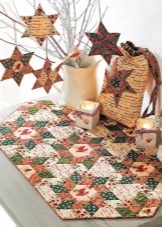

Well, the European population that populated the New World brought their traditions to America. And scarcity conditions have become a catalyst for the development of patchwork. Today, a huge multinational trend is called a patchwork.
And in Danish cozy apartments, and in the bright interiors of South Americans, and in a Russian house - everywhere you can find amazing, warm, beautiful patterns of patchwork.


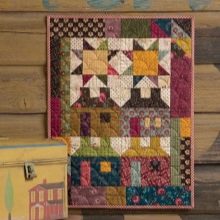
Kinds
Patchwork types are understood as a huge number of techniques and techniques, techniques and features of working with shreds. Since at every point on the planet the masters have their own opinion on patchwork, they decided to fix this right in the names of the types of patchwork.
Important: quilting and patchwork are practically the same thing.. It will not be a mistake to call patchwork each of these words. “Patchwork” translates as “patchwork”. This quilting involves 3 required layers of fabric (main fabric, filler and backing), and all these 3 layers are quilted.
But today, both names are used to refer specifically to patchwork, and this is not a blunder.


Now consider the types of patchwork.
- English technique. This is the most popular destination in the world. Clear geometry, laconic drawing and rather reserved decorative elements are characteristic of it. Things are sewn from parts of the same shape and size.

- Classic technique. This is all the same English style, but the product is a canvas sewn from calico squares of two primary colors, strictly ordered. It is recommended for beginners to start with the classics: everything is clear, simple, affordable.

- Crazy. Great creative style for free artists. This is an extravagant mosaic of shreds, the difference of which is not even in the apparent randomness of the arrangement of fragments, but in the decorative processing of the seams between them.
Seams are completely hidden behind elegant embroidery, braid, lace, beads, beads, etc.

- Eastern technique. Here classical geometry, free patterns, and severity and smoothness of lines are combined. In this style, you can create not only ornaments and symmetrical images, but also plot paintings. The difference between the eastern patchwork is that it uses silk. Many finished products are decorated with Chinese and other works with brushes, fringe, beads, stones, embroidery.

- Japanese style. In it, the traditional Japanese technique “sashiko” (“needle forward stitch”) is combined with “yoshigi-re”. The real Japanese patchwork is sewn only by hand. The technique of "borough" with a pronounced ethnic orientation resembles darn. It deliberately uses numerous patches, but skillfully sewn, aesthetically perfect.

- Knitted patchwork. Separate large branch. It can combine knitted fragments and colored patches of fabric.

The patchwork is diverse, but that's why it is interesting.. Combinations of fabrics and contrasting threads, combinations of shapes and decorative stitches, the appearance of new lines and transitions are like a creative puzzle, the needlewomen are ready to spend days and nights on solving them.




Execution technique
For beginners, for inspiration and a comparatively quick successful result, you need to do something simple, in the most ordinary technique. That is, in the traditional.The basis will be a fabric canvas on which sewn shreds are superimposed from the inside. Folded from pieces (squares, stripes), the picture will be the front side of the product.

The principle of tailoring "mill" (it is used by beginners for training) is as follows.
- In one block there are 2 squares of colored and plain fabric. To sew a blanket or blanket, you need several blocks. Color and solid squares must be placed with the front side inward, making diagonal markings.
- Next, the fabric should be stitched at a distance of 6 mm from each diagonal side.
- A diagonal stitched square needs to be cut.
- The seams should be ironed, the squares should be opened and ironed again.
- The protruding parts are cut, the block is prepared for stitching.
- The first two squares, as well as 3 and 4, need to be sewn vertically together.
- Unfold the squares, iron them, sending the seams in different directions.
- Two blanks should be sewn together, the seams should be in the middle, directed in equal directions. And iron again.
- You can sew a strip between the blocks, combining all the details into one.


The easiest technique is the checkerboard squares technique, as well as the Russian square and fast squares technique. The stripe technique will be no less bright. Geometric figures (triangles, rhombuses) in the patchwork are also quite common.
But the wrong details require more experience and skill, and products from rounded elements without a certain level of skill can not be done.

The easiest way to master the technique is in the process, because from simple scraps of different fabrics a self-sufficient product is assembled. It can be done in any style: from traditional to oriental. The value of such a product is great: everything that is done with high quality by one's own hands cannot be compared with the mass market.


Work stages
If needlework is your calling, then you probably already have fabrics and various decorative elements in your collection that can be used in patchwork. If you decide to start from scratch, you will have to look for cloth and tools. Good, high-quality, beautiful fabrics can be ordered in the online store.

Material selection
You can take new or used materials. The main thing is that they are clean and washed (even a new fabric needs to be washed for shrinkage). If the fabric patches are not new, it makes sense to slightly starch and iron them.

Experts recommend not to forget about the following selection rules.
- The easiest to work are cotton fabrics: they keep their shape perfectly, are most convenient in cutting and sewing. Finally, they are natural and relatively inexpensive. Napkins, potholders, lunches, teapots, various wraps, pillows and blankets are beautifully made of cotton.
- Gabardine, tweed and even drape can also be used in patchwork mosaics. They make panels, thick rugs and rugs.
- Silk shreds can also be used, but silk fragments wear out quickly. Therefore, for modeling patchwork patterns, silk can be used, but for pillows and rugs, which are used in practice, it is not worth it.
- Knitwear for patchwork rarely used because it is difficult to sew from it. But things made of leather (including artificial ones) are done regularly.



Fabrics can be combined, but this is not always successful. On sale today you can find kits for creativity, which in the kit already have fragments of fabric that fit perfectly together.

Scheme selection
The scheme is an instruction that will allow you not to get lost in colored shreds and do everything technologically correct. Today it’s not necessary to draw the diagrams yourself: just find an interesting option on the Internet, print it on a printer and cut it into details. More experienced craftsmen make patterns themselves, because they can intuitively understand how the new patchwork pattern will look.

Little tips:
- no need to throw away patterns even if it seems that you are unlikely to want to repeat a specific product or everything is clear and memory will not fail;
- for storing circuits convenient to use file folders, since in the boxes the circuits crumple, get lost, get confused;
- on the details of the scheme, you can make notes regarding the choice of fabric: when the product is ready, it becomes clear whether colors and materials are suitably arranged;
- pattern making scissors in dashed lines: not all templates leave a seam allowance, this must be taken into account;
- you can independently draw up a diagram on whatman paper: indicate on the drawing an ornament or drawing, the required number of parts, possible colors of fabrics.



Sewing is a technological process. Only very talented people with an excellent eye and an enviable sense of composition can do without patterns and patterns. Do not overestimate your own capabilities: it is better to tinker a bit longer, but the result will be impeccable.

Determination of the method of connecting rags
The most actively used are 2 patchwork sewing techniques: American and block. In the first case, identical figures are swept to each other using paper patterns. Then a seam allowance is made, and then the part is again bent. Block tactics are more often used in modern master classes. Triangular or square elements are connected in blocks. Then they are sewn to the base, getting a voluminous beautiful pattern.

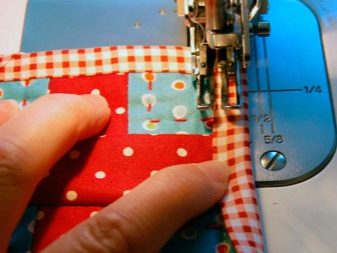
If we are talking about the crazy patchwork, the seams are treated in a fundamentally different way: they must be decorated. This can be a masking of the seam with elegant braid, lace, ribbons, beads. An artistic seam (“curly”), unusual options imitating bird tracks, a Christmas tree, falling snowflakes, etc. are popular. Buttons, beads, beads, rhinestones can be woven and sewn into art stitches.
Important: after connecting the parts, very often they need to be ironed. Some needlewomen use a compact iron for smoothing arrows and sleeves.
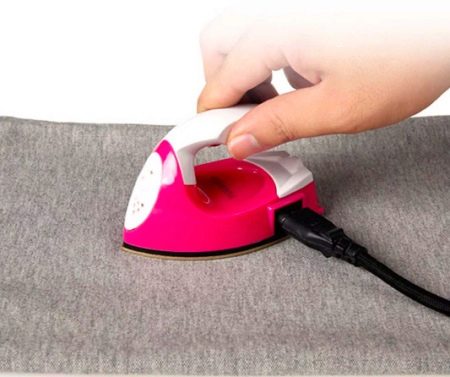
Secrets and useful tricks
First, it will be useful to learn the basics of tailoring: there are many small tricks that will come in handy in the work. For example, frames are considered the most convenient templates. The inner part should be equivalent to the size of the fragment, taking into account allowances for the seams. In the manufacture of patterns, the frame is circled twice, and cut only along the outer contour - the inner contour shows the seam line.
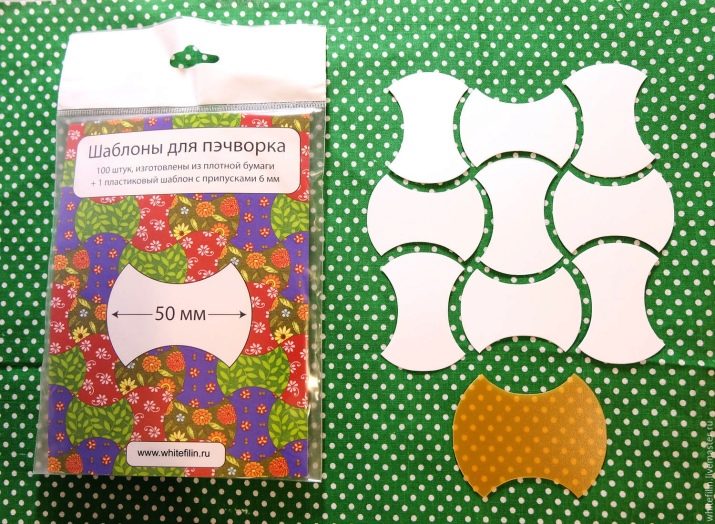
The pattern is transferred to the fabric with chalk, because any pen, alas, will leave traces. It is only necessary to do cutting along the shared thread (to avoid skewing). Shreds are cut with ordinary scissors or a cutter.
Of course, with a roller knife, technology is accelerated: large strips are immediately cut off, which are subsequently convenient to cut into smaller parts.

Consider 7 important points in the patchwork.
- Work needs to start from the center. The central flap is usually selected the most noticeable, bright, accent. It can be glued to the base or fastened with a pin. One patch in the fabric mosaic is sewn to another, the movement is in the same direction. The product looks great in which the triangle or polygon becomes the central part.
- It’s very important to mix colors correctly, after all, coloristic decision is sometimes the main factor of success. Shreds can be contrasting, have different shades of the same color. You can move from light to dark or vice versa. It is useful to focus on color bars.
- For beginners, it makes sense to look at the contrast technique. One patch with another can be sewn according to the rule of “color chaos”.
- Decatability cannot be avoided. This term refers to wet-heat treatment, which eliminates shrinkage of the fabric during sewing and use.
- You need to iron fragments of a patchwork product. If the fabrics are contrasting, seam allowances are ironed under the darker side.If two rows are sewn from the component parts, all seam allowances of one row are ironed in one direction, the allowances of the second in the other.
- Long strips on the ironing board are not placed horizontally, but vertically. This eliminates the bias of the stripes in one direction.
- The stitch is always carried out from the center to the edges. First, the corners of the upper and lower layers are sewn together (if it is quilting).

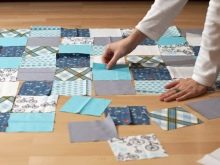
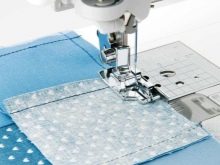
Where can i apply?
The variety of things made using the patchwork technique is impressive. A cloak on a chair or chair, rugs and bedspreads with appliqués, bedding (especially for babies), textiles in the kitchen, decor in a room for children - and this is only the beginning of the list of patchwork products.

Let's see which products are most popular among needlewomen.
- Lunchmates. These are kitchen napkins that decorate the table, adding coziness to the space. You can make a long track with hanging edges on the table.

- Tablecloth. Difficult and long work, but such a thing is quite capable of becoming a family heirloom.

- Apron. A very simple product, even schoolgirls will cope with this task.

- Pillowcase. If it is time to update the covers for sofa cushions, bright patchwork patterns will come to the rescue.

- Kettle Warmer. Very cozy decor, can be made in the form of houses, stars, flowers, Christmas trees, etc.

- A box for all sorts of handmade little things. If the craftswoman wants to present herself, then potential customers will not leave such an element in social networks.

- Cosmetic bag or soft bag for jewelry. The product looks like a kaleidoscope.
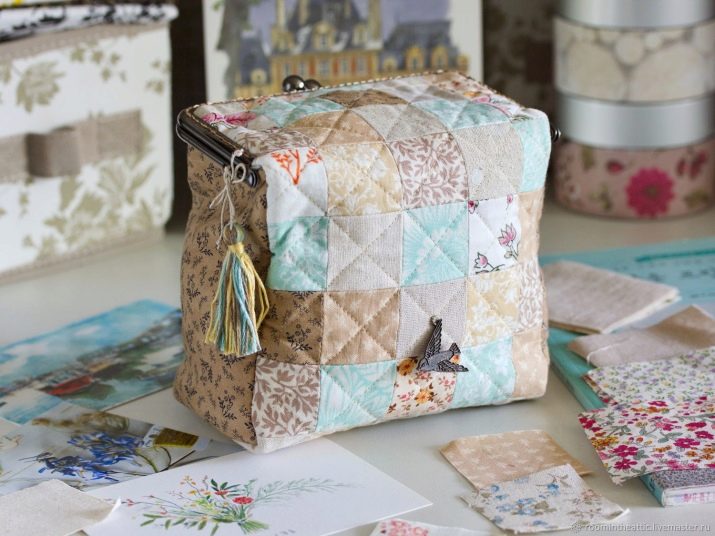
- Lady's bag. Most often, this is a summer option, but you can also practice leather patchwork.

- Coat. A task for the pros, since it turns out absolutely designer thing (like a vest, pullover, sweater, jacket).

- Cape for furniture on wooden legs (for example, a Christmas tablecloth for a festive coffee table).

- Mudboard (board of wishes, notes, visual information). Here you can pin stickers on a textile patchwork substrate. For a needlewoman doing reviews of her work on social networks, this will be an interesting trick.

- Christmas decorations. Birds, roses, mouth-watering pineapples and tangerines, sweets - all this can be easily and quickly done in patchwork style.

Original ideas
For inspiration, examples are needed: bright, accurate, maybe unusual. And the next review contains just such work.
- Quilt can be one of the fond memories of a child’s childhood. And it will also be an attribute of the child’s first photo shoots.
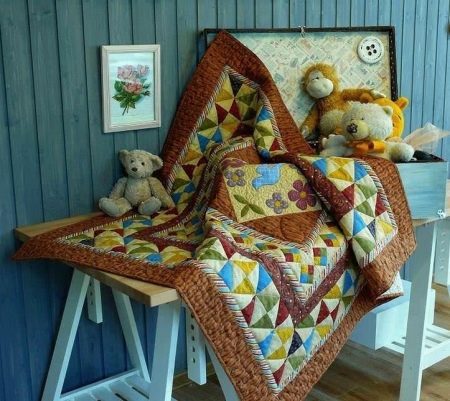
- Painting on the wall is an elegant solution. The patchwork will suit a huge number of interior styles.

- Very cute pillows just for beginners who are afraid of complex shapes.

- Napkins and lunch mats make any interior warmer and more comfortable.

- The path to the table - self-contained decor element. You can make seasonal and holiday options.

- With such bag You can go on an evening walk, easy shopping and even a short trip.

- Cute teapot warmers Loved by all households and guests.
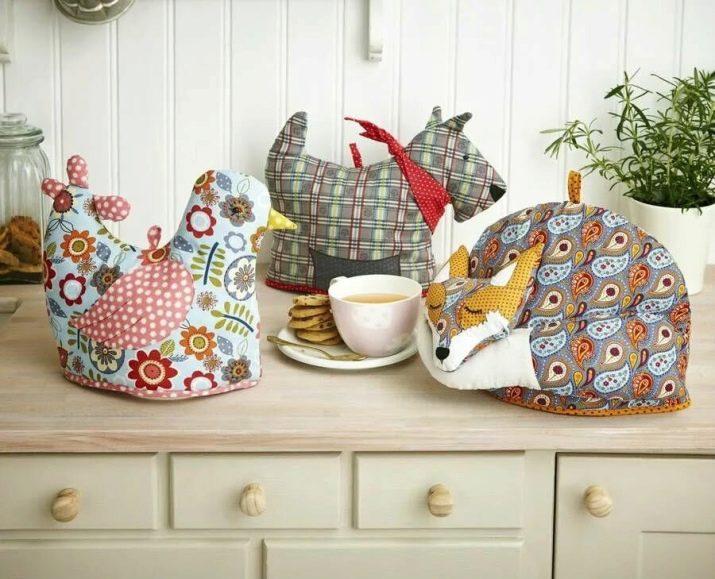
- For summer photo shoots and sunny mood this sundress just a must!

- Bedspread on a sofa in a drawing room should have to rest and comfort. With this task, this coverlet will surely cope.
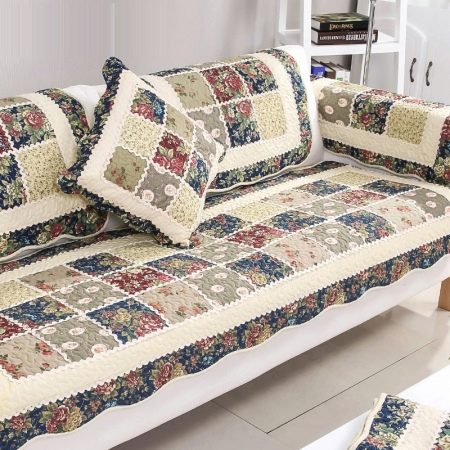
- Graceful handbag in the Crazy Patchwork technique: elegant, vintage, catchy.

- Patchwork transforms space, sets the mood and disguises small imperfections in the room.

- Carpet or panel - you can call it anything you like, the main thing is that it is very pretty.

The video below shows three ways to build patchwork blocks.










